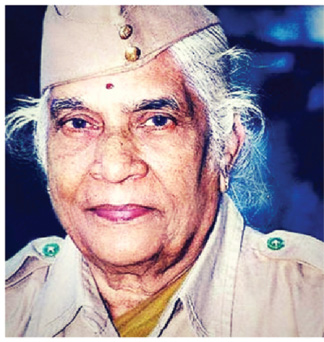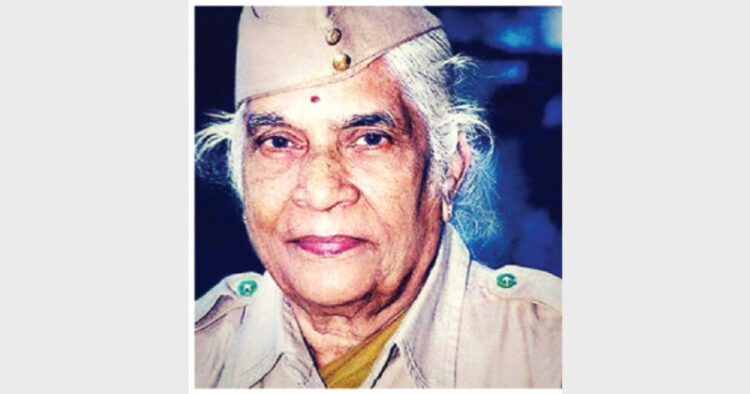 Rather than being just symbolic, I celebrated this Republic Day with a forgotten soldier of INA. Tried to pen down the feelings of those memorable moments
Rather than being just symbolic, I celebrated this Republic Day with a forgotten soldier of INA. Tried to pen down the feelings of those memorable moments
Shwetha Prasad
Every once in a while we are inspired to break from the norm and do something out of the ordinary. My father made me do the same on Republic Day when he read an online article about a freedom fighter called Saraswathi Rajamani and suggested if we could go and visit her to pay our respects. All we knew was that she stayed somewhere in Royapettah Chennai and we left our house to go on a wild goose chase. No one seemed to know her but we didn’t give up. At last, a vegetable vendor recognised someone who fit our description and she said, ‘There’s someone here in these flats. She’s really old and a lot of people come to see her but I don’t know if she’s a freedom fighter.’ Such is the tale of a forgotten Indian National Army (INA) soldier.
We were worried if it would be intrusive but as soon as we went in, she welcomed us and told us to have a seat. After asking about us, she warmed up to us and gave us refreshments. She’s 92 years old but yet she wanted to make her guests take coffee or tea. A couple of people came to see her while we were there and everyone told us the same thing – that she won’t let her guests leave without giving them something. The walls of her house were decked with framed photos of Netaji Subhas Chandra Bose and the awards she received over her lifetime. Her house felt like a memorabilia of our Indian Independence movement.
The Hero of Asia Tokyo: Paying rich tribute to Netaji Subash Chandra Bose on his 120th birth anniversary the Hindu Swayamsevak Sangh (HSS) workers along with Team Netaji Japan |
She recalled her memories slowly but in a very lucid way. She would think really hard so as to not skip the tiniest details of an incident. She spoke in English, Tamil and Hindi. She told us about her childhood in Burma, her days as a spy where she dressed up as a boy with the moniker of ‘Mani’, her run-ins with famous people, how Bose gave her the title of ‘Saraswathi’ and many such incidents. She spoke for hours together. We didn’t have the heart to leave her at all.
Just next to her seat is a tailoring machine that she still uses to stitch clothes for the homeless people. When asked if we could give her something, her grandson said ‘Give her materials to stitch. She will accept only that.’ You just have to wonder how selfless someone must be to dedicate her life completely for the well being of others. When we left her house, she shouted her old battle cry of ‘Jai Hind’.
Here was a woman who has met national leaders like Bose, Gandhi and Nehru (to state a few) personally. Here was a woman who was so brave and selfless that she decided to become a soldier. Here was a woman who literally took a bullet for our country. Here was a woman who was still giving to the society in some way or the other to people. Here was a woman who was living her life to the fullest. What can you do to such a woman? You sit humbled before her because you can’t thank her enough. We all have an ingrained respect for war heroes and army veterans. We look up to them. But when we meet one of them and see how they have a heart of gold, all we can do is learn from their humanity and hope to take that lesson with us for
lifelong. It was a truly enriching experience. The hospitality extended by her even at the age of 92 years left us speechless and emotional.
On the whole it was a memorable day for me and my parents, that too on a Republic Day. I am giving below a brief sketch of her life.
Who is Saraswathi Rajamani?
Saraswathi Rajamani was born in Burma, in a family of freedom fighters, in 1927. Her father, an affluent miner from Trichy, was a staunch supporter of the freedom struggle; he settled down in Burma to escape arrest by the British authorities.
Rajamani grew up in a liberal household where there was little to no restrictions for the girls. As Rajamani grew up, she started hearing a lot about Netaji and his INA. While she had always supported the nationalist movement wholeheartedly, it was Netaji’s powerful words that kindled a fervour in her to fight for her nation.
Gutsy Teenager
She was just 16 when Bose visited Rangoon at the height of World War II to collect funds and recruit volunteers for INA. Unlike Gandhi ji and the Indian National Congress, Bose urged everyone to take up arms to liberate India from British rule. Deeply impressed with his fiery speech, Rajamani removed all her expensive gold and diamond jewellery and donated it to the INA.
This magnanimous action did not fail to attract the attention of Bose who, on enquiring, found out that Rajamani was the daughter of one of the wealthiest Indians in Rangoon. The very next day, he arrived at Rajamani’s
residence to return all the jewellery.
On meeting Rajamani’s father, Bose said, “Due to her innocence, she gave away all her jewellery. So, I have come to return it.”
While her father, a freedom fighter who had himself made massive donations to Bose’s cause, simply smiled in reply, an indignant Rajamani said, “They are not my father’s, they are mine. I gave all of them to you, and I will not take them back.”
So stubborn was the teenager that Bose could not but admire her determination. In the very same meeting, the 16-year-old urged Bose to recruit her in his army. So
persuasive was she that the very next day, Bose
recruited Rajamani and four of her friends as spies in INA’s intelligence wing.
Disguised as young boys, the girls started working as errand boys at British military camps and officers’ houses. As covert agents behind enemy lines, they were responsible for intercepting government orders and military intelligence from the British officers and handing these over to INA.
Rajamani (as a boy her name was Mani) and her friends masqueraded as boys for almost two years to gather intelligence on British movements. While the unit had been told to avoid getting caught at all costs, one of the girls was once caught by the British. Knowing the consequences of being caught, Rajamani decided that she would try and rescue her fellow spy.
The gutsy teenager dressed herself as a dancing girl, drugged the officers at the prison, and rescued her colleague. As the girls were escaping, they were shot at by the Britishers and Rajamani suffered a bullet wound in her right leg. Still bleeding as she ran, Rajamani and her friend climbed up a tree, where they camped for three days while the British carried out their search operation.
The bullet wound left her with a permanent limp, but Rajamani was proud of it. For her, it was a reminder of her exciting days as an INA spy.
Later, Rajamani would often recall how delighted Netaji was at their brave escape and the proud moment when she was given a medal by the Japanese Emperor himself, along with the rank of Lieutenant in INA’s Rani of Jhansi Brigade. When INA was disbanded after the British won the war, Saraswathi and the other INA members returned to India on Netaji’s instructions.
Saraswathi Rajamani and her family gave away everything they had and made their way to India. Sadly, the
family that gave everything they had to the freedom struggle, had to live a life of penury on their return to India.
For a long time, this veteran freedom fighter lived alone in a dilapidated and cramped one-room apartment in Chennai, adorned only by several
photographs of Netaji Subhas Chandra Bose. Recently, the Tamil Nadu Government allotted her a house, albeit an old one in a housing colony.
Age has hardly withered Rajamani’s spirit and determination to serve her nation. Even at this old age, she visits tailor shops and collects cloth scraps as well as rejected fabrics from them. She uses these materials to make clothes and then she donates to orphanages and old age homes. During the devastating tsunami of 2006, she also donated her meagre monthly pension as a freedom fighter to the relief fund.
(The writer is a Chennai-based blogger)













Comments